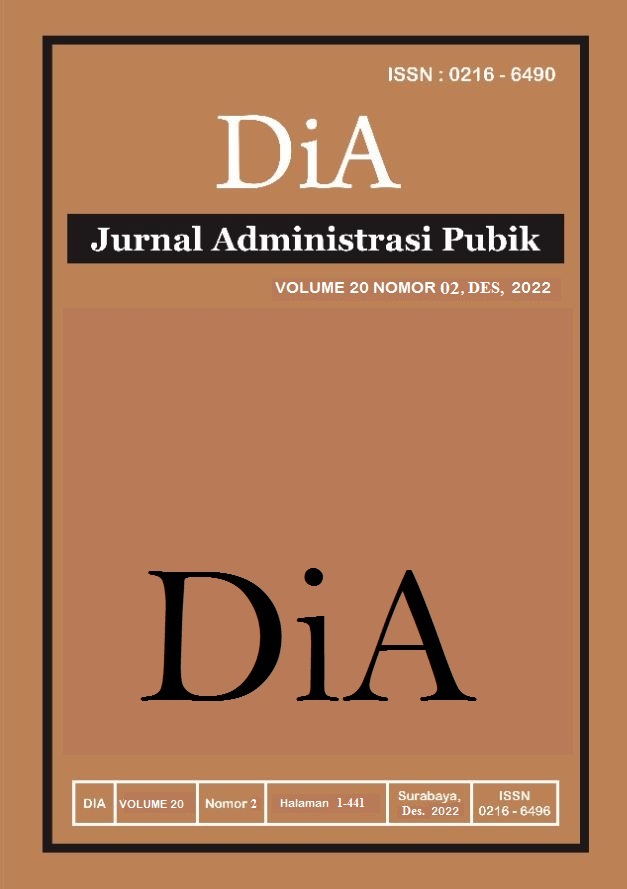JOB ANALYSIS FOR PERSONS WITH DISABILITIES IN STATE CIVIL APPARATUS NEEDS PLANNING
DOI:
https://doi.org/10.30996/dia.v20i02.6652Keywords:
Job analysis, Person with disabilities, planningAbstract
As a form of respect and fulfillment of the rights of persons with disabilities in working, the Government issued an affirmation policy by opening the formation of persons with disabilities as the Aparatur Sipil Negara-ASN (State Civil Apparatus). In the implementation of ASN recruitment, there are several problems faced, including the formation of persons with disabilities that are not filled and requirements that have not accommodated the interests of persons with disabilities. One problem is the non-fulfillment of the formation, or the tan caused by the job analysis. This study aims to describe the process of job analysis for persons with disabilities in the recruitment and selection of ASN with a type of narrative descriptive research. Data collection was carried out through interviews with informants from the Ministry of State Apparatus Empowerment and Bureaucratic Reform, the State Civil Service Agency, the Ministry of Social Affairs and Australia Indonesia Disability Research Advocacy Network and document studies by reviewing the literature on job analysis for persons with disabilities and regulations related to job analysis. The results showed that the process of analyzing job analysis of jobs in the context of planning ASN needs as stipulated in the Peraturan Menteri Pemberdayaan Aparatur Negara dan Reformasi Birokrasi Nomor 1 Tahun 2020 concerning Job analysis and Workload Analysis does not specifically regulate for persons with disabilities. The availability of facilities and the lack of a comprehensive understanding of the issue of inclusivity in the fulfillment of the right to work for persons with disabilities are factors in the emergence of job requirements that are not accommodating to all kinds of disabilities. The provision of accessibility and decent accommodation has not been a major concern in the preparation of the ASN job analysis.
Downloads
References
Peraturan Menteri Pendayagunaan Aparatur Negara dan Reformasi Birokrasi Nomor 27 Tahun 2021 tentang Pengadaan Pegawai Negeri Sipil.
Pendayagunaan Aparatur Negara dan Reformasi Birokrasi Nomor 29 Tahun 2021 tentang Pengadaan Pegawai Pemerintah dengan Perjanjian Kerja.
Peraturan Pemerintah Nomor 60 Tahun 2020 tentang Unit Layanan Disabilitas Ketenagakerjaan.
Pynes, Joan E. (2004). Human Resources Management for Public and Nonprofit Organizations (2nd Edition). San Fransisco: Jossey-Bass.
Reilly, P. (2003). Guide to Workforce Planning in Local Authorities. Employers’ Organization for Local Government: London.
Rohman, Y. F., (2018). Eksklusi Sosial dan Tantangan Penyandang Disabilitas Penglihatan terhadap Akses Pekerjaan. Indonesian Journal of Religion and Society, 1(1), 51-66.
Wardah & Susiana. (2019). Pemenuhan Hak Penyandang Disabilitas dalam Mendapatkan Pekerjaan di BUMN. Program Studi Magister Ilmu Hukum Undip. Law Reform, Volume 15, Nomor 2.
World Health Organization. (2015). WHO Global Disability Action Plan 2014-2021. Geneva: Author.
Undang-Undang Dasar Negara Republik Indonesia Tahun 1945.
Undang-Undang Nomor 8 Tahun 2016 tentang Penyandang Disabilitas.
Yeo, R & Moore, K. (2003). Including Disabled People in Poverty Reduction Work: Nothing About Us, Without Us. World Development, Vol. 31, No. 3, pp. 571–590.
_______. (2019, 19 November) Seleksi CPNS 2019 dinilai tak ramah disabilitas, transgender dan perempuan, PPDI: 'Katanya membuka seluas-luasnya, tapi syaratnya membatasi' https://www.bbc.com/indonesia/indonesia-50463761.
Downloads
Published
How to Cite
Issue
Section
License
The DiA journal allows authors to retain the copyright of their papers without limitation. Authors may grant publishers non-exclusive publishing rights to publish articles. Granting first publishing rights to publishers also qualifies as unlimited copyright (because there are no restrictions imposed by publishers on author copyright).







